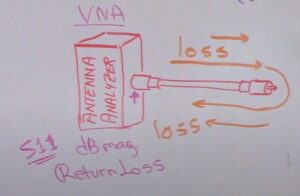A recent online video provides instruction on how to measure loss of a section of coax cable, loss to mean Matched Line Loss, \(MLL=\frac{P_{in}}{P_{out}}\) when the cable is terminated in its characteristic impedance Zo, and which can be expressed in db as \(MLL=10 log_{10} \frac{P_{in}}{P_{out}}\). Note that MLL in dB is ALWAYS a +ve value for a passive DUT such as this.
There is nothing new in the method, it appears in lots of analyser user manuals, and has a built in assist in many analysers.
The video deals with the case of an antenna analyser that has a ‘measure cable loss’ function and using a VNA. Lets use the VNA graphic as it shows more detail of what is happening.

Above is the video’s graphic for the case. The narration says to use the dB magnitude of s11 or ReturnLoss as equivalents. They aren’t equivalent (a hammy Sammy thing), \(ReturnLoss=-20 log_{10}|s11|\) or \(ReturnLoss_{dB}=-s11mag_{dB}\) (both wrt the VNA reference impedance). Continue reading On testing coax cable loss with an analyser / VNA – part 1
Last update: 5th September, 2021, 3:03 PM





